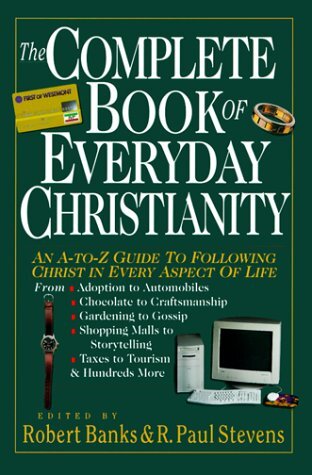Architecture, Urban
Book / Produced by partner of TOW
The first arresting image of urban architecture in Scripture is the tower of Babel—hardly a great beginning for a biblical view of the built environment. Starting with the tabernacle (in the wilderness wanderings) and later the temple, we see a much more positive approach. God gave the children of Israel the design for these structures, not just providing the overall size and shape but detailing such items as blue pomegranates as part of the decoration. In fact, we learn in the New Testament that the tabernacle was “a copy and shadow of what is in heaven” (Hebrews 8:5; Hebrews 9:24). The vision of the heavenly city at the end of history also contains many specific materials and measurements (Rev. 21:9-21).
Modernism
Modern urban architecture is set in a very different world. In the early twentieth century, philosophy shaped buildings more than functional concerns did. Mies van der Rohe, Adolf Loos, Walter Gropius and Charles Edouard Jeanneret (better known as Le Corbusier) remade the world. With technical advancements, the elevator and skeleton construction (resulting in nonweight-bearing walls), combined with a morally superior, utopian outlook, this small handful of architects left their image on modern cities worldwide. Their ideas on town planning and design have made close kin of downtown Boston, Brasilia and Beijing.
A number of basic doctrines drove these changes (these owe much to Brent Brolin, The Failure of Modern Architecture):
Inventive technology. New building materials, like glass, steel and reinforced concrete, brought forth new forms.
Worship of change. New processes made stylistic traditions irrelevant. Modernism “has never been presented as a style; it has been considered a movement of truths for so long that we are unable to think of it as a set of arbitrary, systematized aesthetic choices” (Brolin, p. 13).
Simplicity. With modernism the inevitable result of design would be something reductive, pared down, simplified. In a way, modernist building shape was inspired by minimalist painting and sculpture. Decoration on a building was equated with crime. Simplifying a building meant getting rid of nonessentials. In this way function was stressed over ornamentation.
Antihistorical. Modernists turned their backs on tradition in favor of a Darwinian idea of progress. In 1923 Le Corbusier declared traditional architecture to be a lie. Materials had to be “honest,” and architects were to be true to themselves rather than just mirror the past. According to Adolf Loos: “The time is nigh, fulfillment awaits us! Soon the streets of the city will glisten like white walls. Like Zion, the holy city, the capital of Heaven. Then, fulfillment will come!” (Brolin, p. 17).
Standardization. Hand in hand with new materials was mass production. The modernists wanted to rationalize the industry so that wherever buildings were built, the same principles would apply. The impersonal look of concrete would replace hand-shaped local materials. “Wherever western civilization has penetrated, impersonal forms intrude upon the traditional profiles of cities, towns and villages” (Brolin, p. 12).
Planning. To Le Corbusier, Manhattan was a mess. The buildings were getting big, to be sure, but it was all muddled. He preferred “La Ville Radieuse,” the radiant city, an urban arrangement of large skyscrapers in parklike settings connected by rapid transit to other areas of the city containing different functions. Le Corbusier spoke of humankind’s need for “greenery, sunlight, fresh air and space. All very true; but man’s primary yearning, it seems, is not for great expanses of open space, but for other men, women and children” (Blake, p. 88).
The automobile was crucial to this ideal city. “We watched the titanic rebirth of the traffic—cars, cars! speed, speed! One is carried away, seized by enthusiasm, by joy . . . enthusiasm over the joy of power” (Hughes, 188). Ironically, what they eliminated was the life of the street. In the Radiant City—the Vertical City—the elevator ruled, not the sidewalk (see Public Spaces). (And you know what it’s like on an elevator for relationships of even the most basic type.) The inhabitants of such a modern city go to the old town center, where there are shops, cafés, people. When you travel to a city as a tourist, you end up on the same crowded streets, maybe medieval, probably meandering, rubbing shoulders with people—all miles from the rational park settings of the high-rise with its “machines for living” (Le Corbusier).
All that the well-intentioned planning tended to produce was ghettos. “The finest public housing projects to be found anywhere in the world, and designed according to the noblest precepts, are turning into enclaves of rape, murder, mugging and dope addition, with the only way out a change of dynamite to reduce those noble precepts to rubble” (Blake, p. 11).
In St. Louis in 1972, this came true quite literally. The Pruitt-Igoe development blew up a number of their buildings after continued vandalism. The buildings were impersonal and not in keeping with the needs of the inhabitants.
More could be said about modernism as a world- and city-shaping philosophy, but where does this leave us? Most people who live in cities, anywhere in the world, see the same glass and steel high-rise shapes. What do these mean? The message they send: human beings don’t matter; elevated aesthetic views about esoteric minimalist designs do.
This modernist architectural dictatorship seems to be near its end. What concerns should we as Christians have as we think of its demise?
Concerns and Directions
An appreciation of history. Whatever was built in the past does not need to be rejected or superseded automatically without much thought. Let us learn from its richness, its shapes, its decoration.
A sensitivity to locale. Instead of dropping in a specific setting the same vertical, glass and steel, right-angle building, let us relate what we construct to what is there, in terms of buildings, natural setting, mix of functions and so on.
A willingness to conserve. Don’t destroy just to be up-to-date. The wholesale clearing of our cities’ historic districts is a sad legacy. Tearing down what is too old-fashioned, too small or too whatever needs to be looked at seriously.
The richness of different scales. The visual intricacy of hand-done ornamentation on traditional buildings presents a rich vision, from varying distances. The closer you get, the more you see and learn. The fascination with minimalist art made modernist buildings that give the same information whatever distance you are from them. The fascination with speed also led to the omission of detail—you go by too fast to see or appreciate it.
Attention to local concerns. What kind and size of buildings should be built? With what materials? What traditions need to be respected?
The importance of street life. People need to be with each other. Streets with their shops, churches and parks need to be retained for human contact, places where people can talk about life. In the wake of the destruction caused by the automobile, we need to remember the pedestrian and the variety of sensations available on a walk (see Walking).
A mix of functions. Planning shouldn’t mean segregating uses and placing them tidily in separate areas around a city. A variety of housing types (see Home), public spaces and appropriate commercial facilities should coexist within neighborhoods.
Architecture is the one art form that touches us all. We may not visit art galleries or go to concerts, but we do live in buildings, whether forty stories high or only one with a large backyard. What the city looks like, therefore, concerns us. The view expressed by Philip Johnson, that “architecture would improve people, and people improve architecture until perfectibility would descend on us like the Holy Ghost, and we would be happy ever after” (Hughes, p. 165), sounds like idolatry.
Instead, the architect should give up his or her semidivine pretension to be Creator and Judge, and aspire, as Vincent Scully says, to “the more humane and realistic role of healer, of physician” (Katz, p. 224). No other profession leaves such large and permanent reminders of its ideas. It is crucial that Christian architects and planners think and work together to design buildings and communities that respect the God-given dignity of people. Let us shape homes and places of work where people flourish, jobs are done creatively and healthy relationships are encouraged.
Ultimately, let us look forward to that “city with foundations, whose architect and builder is God” (Hebrews 11:10).
» See also: City
» See also: Neighborhood
» See also: Public Spaces
» See also: Zoning
References and Resources
P. Blake, Form Follows Fiasco (Boston: Little, Brown, 1977); B. Brolin, The Failure of Modern Architecture (New York: Van Nostrand Reinhold, 1976); R. Hughes, The Shock of the New (New York: Knopf, 1991); P. Katz, The New Urbanism (New York: McGraw-Hill, 1994).
—Dal Schindell





